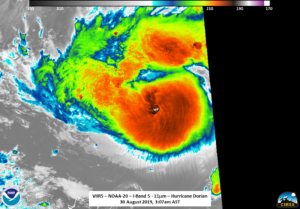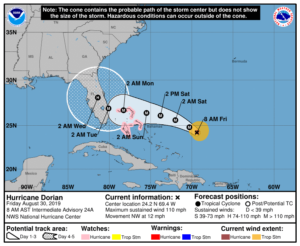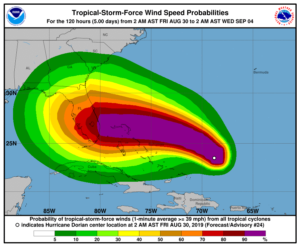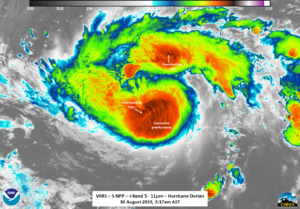« Back to "Hurricane Storm Dorian Aug 28 - Sep 6 2019"
Hurricane Dorian from 30 August
Posted: August 30, 2019
As of the 8am AST (1200UTC) Public advisory, the National Hurricane Center mentioned that Hurricane Dorian had winds of 110mph, which is right on the edge of a Category 3 storm. This was slightly faster than the 0900Z and 0300Z advisories. It is interesting to note that the pressure has varied over the last 9 hours, rising between 0300Z and 0900 and then falling again by 1200Z.
Unfortunately, the GCOM-W1 pass was to either side of Dorian this morning, meaning it was not able to observe the inner structure. It will be in may be in position later today to observe Dorian.
In addition, S-NPP was in the most ideal position for observing Dorian at ~0617UTC at almost nadir view. The IR imagery showed a somewhat circular storm, though it looked a little lopsided.
However, the convection was strong enough to result in several overshooting tops and tropospheric gravity waves. The new moon meant that the only illumination in the DNB was from airglow and a few other light sources, such as several lightning streaks, a couple of ships and a few faint mesospheric gravity waves.
These were not as prominent as previous nights, but were still present. The edge of pass from NOAA-20 at ~0706UTC showed a bit more convective development, though this imagery was affected by the parallax induced by being at the eastern edge of the scan.

As mentioned above, S-NPP had a near nadir pass over Dorian. This allowed the microwave sounder to observe the inner structure of the storm. From the 88.2GHz BT, one can easily see the circulation of the storm, with the convection easily being seen as colder temperatures. In addition, the MiRS Rain rate product also showed the rain wrapping into the circulation center.
As of the latest advisory, Dorian is expected to become a major hurricane later today, impacting the Bahamas and then Florida by early Tuesday.


Warning cone and wind forecast taken from NHC Graphics page for Hurricane Dorian on 30 August 2019 at 9 am CDT
FEMA and other stakeholders are continue to monitoring the situation for impacts to the Continental United States.




